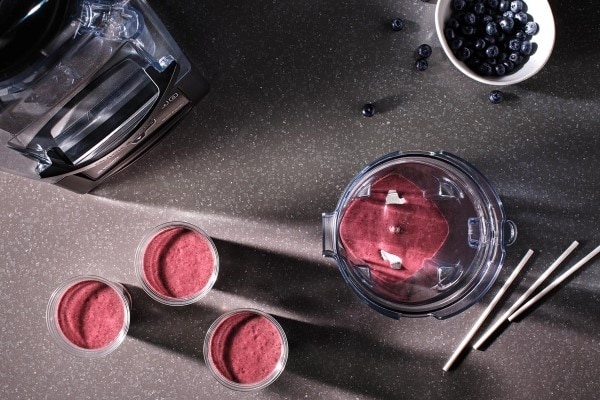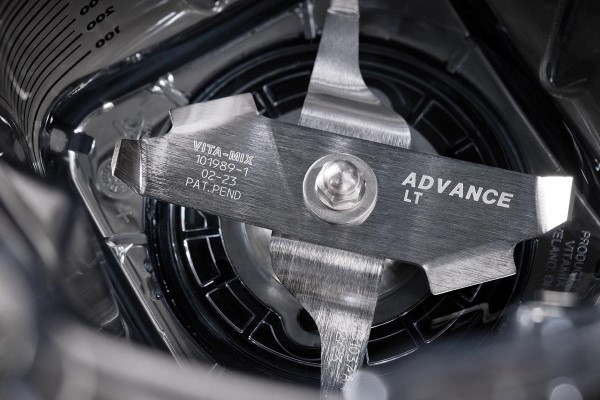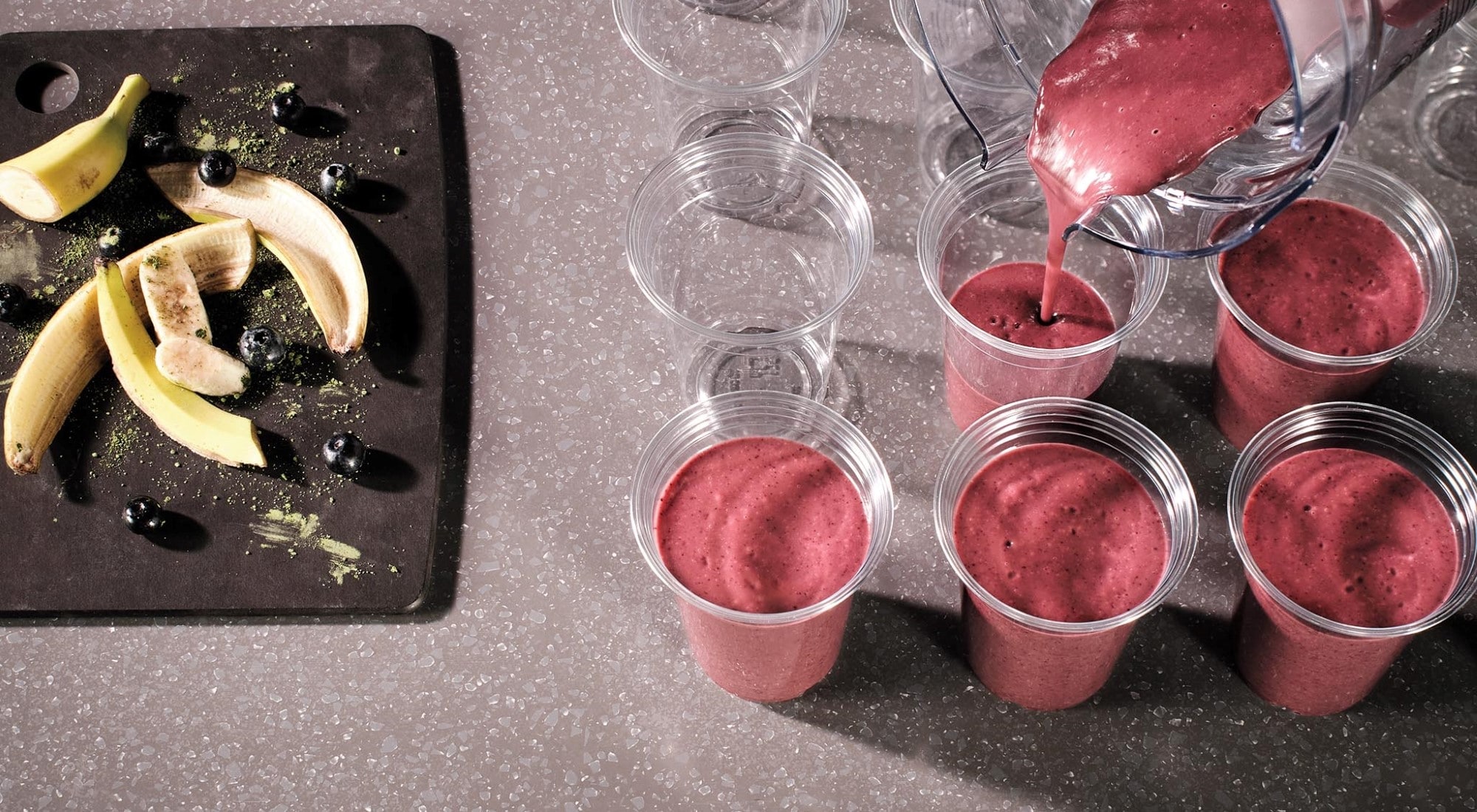Every chain store operator knows that beverages need to be consistent from store to store. The customer experience depends on it.
But now an additional concern about consistency is also getting a lot of attention: Is the beverage consistently blended throughout? Many beverages have become harder to blend in recent years, raising concerns about this type of consistency.
Some hard-to-blend recipes have been around for years, such as smoothie bowls and hard ice cream blends, but others are more recent:
- Extra-thick smoothies with hard ice cream component and protein powders
- Healthy, low-sugar smoothies with powdered additives
- Recipes that reduce liquid contents or are based on mixes and concentrates
Some commercial blenders may have difficulty with recipes like these. They may become slow or bogged down. The result may be something short of a truly consistent blend with the same ideal texture throughout.
In response to this situation, Vitamix ® Commercial developed the Quick & Quiet™, a powerful beverage blender with several innovations that dramatically increase both speed and effectiveness:
- The Accelerate™ Container, uniquely shaped to support aggressive blending
- A blade design consisting of two sets of blades, doubling the cutting-edge capacity
- An efficient motor with extra power and cooling capacity
The result is a blender that powers through hard-to-blend recipes – ensuring they are consistent in texture and consistent from one blend to the next. The Quick & Quiet is also 30% faster than The Quiet One®, also by Vitamix Commercial.

Aiming for Efficiency but Getting Hard-to-Blend
What makes some recipes hard to blend? Some causes are obvious, such as hard or tough ingredients like dried fruit, nuts, or hard ice cream. But many other causes are more subtle and may arise without the operator or recipe development team understanding the reason.
Some food service professionals, for instance, are replacing ambient-temperature fresh ingredients with powders, mixes or concentrates, or frozen ingredients. They may be aiming to simplify the recipe, improve shelf life, reduce errors or other sources of inconsistency.
These are worthwhile goals, but the new recipe is often denser than the one it is replacing, with a reduced liquid-to-solids ratio. Using less than 50% liquid moves the recipe into challenging territory, and sometimes compromises are necessary.
For example, a Midwestern food service company was developing a new version of a smoothie recipe that would replace fresh ingredients with a premixed base. They combined the premix with double the ice and no additional liquid. While the recipe met their goals in terms of efficiency, they ran into an obstacle when blending.
Vitamix Commercial visited the company and developed some options: reducing the ice, adding a small amount of liquid and/or changing the blending program.
In another instance, a chain store aspired to make a more cost-effective milkshake using a shelf-stable powdered form of ice cream, mixed with ice and milk. Naturally, they did not want a crunchy texture. They wanted to fully process the recipe so it would have the temperature and creamy smoothness of a milkshake made from hard ice cream.
The solution Vitamix Commercial provided was to adjust certain variables in the blending program so they could achieve the desired recipe performance in the shortest amount of time.
In both of these examples, the food service company had to balance efficiency with other variables, but a stronger, faster blender, like the new Quick & Quiet, would provide them with greater latitude in pursuing their goals. This robust machine was developed for situations just like these. It can handle denser recipes in less time and yet the quality of the blend remains entirely consistent.
Aiming to Please with Powder
Smoothie and frozen beverage customers are always looking for something new and better, and the companies that thrive in our industry are the ones producing new recipes.
In many of the new recipes, powders play an important role because they fulfill the customers desire for beverages that can be customized to particular functional benefits like being fit, getting more vitamins, fighting disease, building muscle, recovering from a workout, gaining energy, etc. Powders of all kinds can be added to a beverage recipe to customize its focus.
But while powders please customers, they can be hard on the blender. Powders soak up liquid and thicken the mixture, requiring more torque from the blender. Adding lots of ice or frozen ingredients increases the blending difficulty still more.
In general, there are two types of blending difficulty. The first relates to beverages with high ice content, frozen fruit, or other hard ingredients. These blends require extra performance from the blender’s blade and container. The Quick & Quiet is equipped with two sets of blades, with the top set having an especially aggressive pitch to help direct flow and cut the ingredients. Together, the blades double the cutting-edge surface, resulting in especially efficient results with ice and other hard ingredients.
The second type of blending difficulty relates to beverages with lots powder or other dense ingredients, like hard ice cream. These blends place an especially heavy load on the motor. Some blenders may slow down under the strain. But the Quick & Quiet’s efficient motor ensures that the blending cycle remains short and the blend is fully processed and evenly textured.

Other Sources of Inconsistency
When beverages are inconsistent from one serving to the next – or from one chain restaurant to another – the cause can sometimes relate to choices made before the blending cycle. For example, larger forms of ice, such as full cubes, large spheres, crescents, half dice or full dice, present some challenges when used in blended beverages.
For one, they do not pack especially well, so when piled in a container, they are hard to measure. It’s hard to fill a container level with this type of ice because the large pieces will either be under or over the brim. As a result, employees will sometimes overfill the container, which will affect the consistency of the blended beverages.
A better option for blending is to use smaller forms of ice, such as pearls, nuggets or flaked ice. These pack well in a measuring device, with smaller pockets of unfilled space. Also, because they are smaller, they blend quickly.
Look also for other places where measurement errors could occur. Consider color-coded containers, including scoops and spoons of different sizes.
Another tip: Keep an eye on the temperature of your frozen ingredients right before using them – your holding temperatures. When these temperatures rise above the recommended level, they can affect the thickness and consistency of your beverages.
For ingredients coming from long-term storage, such as frozen fruit, remember to allow for slacking time – the time needed for the ingredients to get up to the recommended temperature just before blending.
Finally, as you may know, there is a right and wrong order for loading ingredients in a blending container. If you set up the build station in the right way, you will greatly minimize the chances of an improperly loaded blending container.
Start the process at the farthest point from the blender motor base, adding liquids first, then solids.
At the first stop in the build station, you can load liquids – water, juice, milk. Second, add any powders, such as protein or matcha, so they can dissolve in the liquid and do not form a plume when you turn on the blender. Third, add leafy greens, soft vegetables and fresh fruit. Finally, add frozen fruit, dense vegetables and ice (if applicable). This order ensures the heavier ingredients are weighing down the greens and directing them into the liquid.
Consistency – An Attainable Goal
Consistency is an attainable goal, but it can be challenging. There are so many variables that can affect the texture of a blended beverage, or prevent the customer from experiencing that consistent experience they seek with each serving of their favorite beverage. We have touched on only a handful of these variables in this article. If the recipe calls for powders, pre-mixes, extra-hard contents, or a reduced liquid-to-solids ratio, then the Quick & Quiet will improve your ability to be consistent. You will get faster, better results. Also, you will acquire capabilities that may benefit your menu development team as they aspire to more efficient, innovative recipes.



